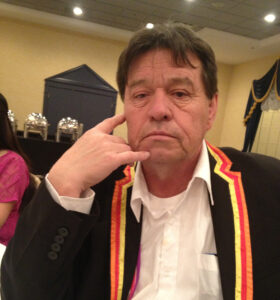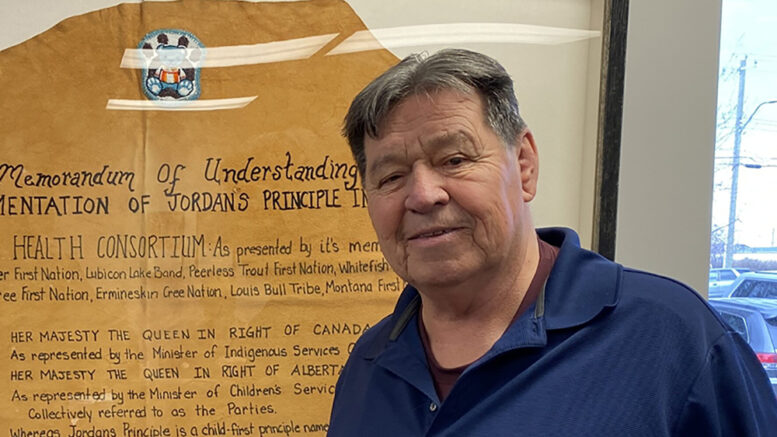By Kinnukana, Local Journalism Initiative Reporter
(ANNews) – Randy Littlechild, member of the Ermineskin First Nation, is a dedicated First Nations leader in the field of healthcare. He currently serves as the Executive Director of Maskwacis Health Services (MHS), an organization committed to providing holistic healthcare to the Maskwacis Cree Nations, which include the Samson, Ermineskin, Louis Bull, and Montana First Nations. In addition to his role at MHS, Randy Littlechild was elected as the Chair of the Board of Directors for the First Nations Health Consortium (FNHC) on October 1, 2024. A founding member of the FNHC, he has been an active board member since 2017, contributing to the organization’s mission to enhance health services for First Nations children and families across Alberta.

Randy Littlechild is Executive Director of the Maskwacis Health Services.
Randy was born at the Charles Camsell Hospital in Edmonton and grew up in the city. He was impacted by the sixties scoop and lived in foster care throughout his childhood. When he left care, he joined the army reserves and chose to work in the medical field. While there he learned about medical first aid and providing medical assistance. He also had an opportunity to work as a registered Nursing Orderly.
While hitchhiking one evening, Randy was picked up by a guy who had a conversation with him about a new, one-of-a-kind program being developed at the University of Alberta. He encouraged Randy to apply. He did, was accepted, and became one of six students who graduated as the first cohort of the new Operating Room Technician Program (ORT). Randy worked as an ORT at the Alberta University Hospital for a few years and then realized that he really liked working in the ambulance area.
Randy then went to work for the City of Edmonton (City) as an employee of the Edmonton Ambulance Authority. At the time, there were no strict regulations and workers only required a class four driver’s licence and first aid training. Individuals also had to be over the age of twenty-five to receive a class four license. While at the City, Randy made history as he became the first certified First Nations Emergency Paramedic in Alberta. Today, they are called Advanced Care Paramedics. The City assisted Randy to take the training at Northern Alberta Institute of Technology (NAIT). He studied from 1983 to 1985 and graduated from the program.
Randy also worked part-time in Maskwacis. While there, he helped the late Ernest Leclair set up an ambulance service in Samson Cree Nation in 1985. It was the first Advanced Life Support Ambulance Service on a reserve in Alberta. Randy said “The beginning of the Maskwacis Ambulance Service is what I am most proud about. We got it going as the first ALS service on a First Nations reserve.”
Nation members are more receptive to First Nation Responders. Today, trained First Nations members are now driving the ambulance and are part of the team. Randy says that there are many benefits to this, “If you are a Cree speaker, and you are talking to an Elder that you are picking up, you can talk to them in Cree and get a better understanding of their immediate needs.” There are lab technicians, x-ray technicians, a lot of people that work in hospitals now but unfortunately not enough First Nations people are occupying those roles.
Randy dedicated thirty-five years at the City in a variety of roles. He even became the first President of the Canadian Union of Public Employees (CUPE) for the City and led workers through two strikes. In Edmonton, CUPE represents workers employed by the city and other public institutions, such as those in public schools, healthcare facilities, and municipal services. Randy said that “we went on strike twice for wages and other things. We got a lot of gains: better wages, ballistic vests, protective gloves, and a lot of stuff for safety, including better hours and better working conditions.”
Randy said that when he started working there was a lot of racism towards First Nations people, even amongst the co-workers he worked with. Some workers would make fun of the First Nations accents. It took a long time for change, but Randy says the newer generation is better. It was hard for Randy to accept, but he let it go over his head and worked through it. Randy cared more about the people he picked up on the street and focused on helping them. He said it also took a while for hospitals to accept the paramedics. They didn’t understand what the paramedics could do, but now they are realizing how important they are to the health team.
Today, over forty years later, Randy continues to create positive change. As the Executive Director of MHS, Randy has helped to create a health system that integrates modern healthcare with Indigenous traditions. Under his leadership, MHS provides holistic care that addresses the mental, physical, emotional, and spiritual health needs of the Maskwacis Cree Nations.
Randy encourages First Nations youth to get involved in the health field and said, “Don’t be scared. Go ahead and take the nursing program, the licenced practical nurse, go become an emergency medical technician ambulance worker or advanced care paramedic. It only takes a few years of study to begin. Also, Nursing is up to four years of study and you can go on to take a Masters degree as well. You have to have a strong stomach; you have to have a strong heart.”
Randy obviously has both a strong stomach and a strong heart. His extensive involvement in both frontline work and healthcare administration underscores his commitment to improving the health outcomes of First Nations and promoting cultural values within the broader health field. Randy’s journey is more than just about treating physical ailments – it’s been about empowering First Nation’s to take control of their own health while honouring their cultural heritage.



I enjoy reading positive stories about people and their lives. It’s a shame that we often don’t learn about the knowledge and experience they have. What a great way to learn !